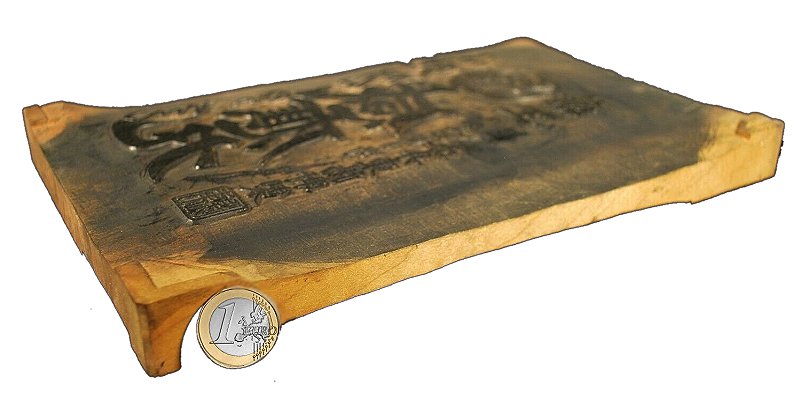 |
||
| |
|
|
 |
||
| Woodblock
and Wodblock Print Click the picture for technique and history |
A woodblock from a pharmacy that sold childrens
medicine. The medicine was to calm children down when they were
having a tantrum or were overly excited.
The kanji in the top right of the woodblock plate states, this medication is for small children (小兒, shōni). The crane in the top middle would be the historical samurai crest for the family that made this medicine. Kobayashi Asahina from the Soga Monogatari wears the same samurai crest. The kanji to the left of the crest states this is 'superb medicine' or literally "Drug King" (薬王, Kusuri-ō).
The kanji in the top right of the woodblock plate states, this medication is for small children (小兒, shōni). The crane in the top middle would be the historical samurai crest for the family that made this medicine. Kobayashi Asahina from the Soga Monogatari wears the same samurai crest. The kanji to the left of the crest states this is 'superb medicine' or literally "Drug King" (薬王, Kusuri-ō).
The large kanji down the middle states it's for mellowing out children and to the left of that says it was made by Yasui Toyoken. On the back of the hangi s a column describing some other medicines Mr. Yasui makes: Eye drops, eye medicine, medicine for after having a baby and medicine that heals everything. This part was printed on the same page as the other side.
This being the late 1800's (maybe the early 1900's) we suspect Mr. Yasui's medicine may have been mixed with an opiate, maybe codeine or morphine. Codeine and morphine are very effective cough suppressants, but unfortunatly with severe side effects. It was the time period when Coca Cola contained cocaine, and Heroin was a trademark of Bayer-Leverkusen Pharmaceuticals.
The hangi (版木, はんぎ) is made of Japanese cherry wood and measures 27.5 x 17 cm. The printing plate is about 2.5 cm in thickness (i.e. roughly the diameter of a 1 Euro Coin). It weighs just about 0.53 kilogram. Historically wood blocks were the only way the Japanese knew for printing documents, books or pictures until the late 1800's. After that they went to movable type and lithographs.
Often woodblocks plates would be used several times, and then eventually the wood would be planed down and carved again for something else, because the right kind of tight grained seasoned Japanese cherry wood was quite valuable. Consequently there are not a lot of these woodblock plates left, and most of them eventually being destroyed. Because most of Japan's cities were burned down during WW-II, this would have resulted in a lot of them disappearing, as most printing was done in the cities.
The classical Japanese woodblock printing process had allotted three different roles and professions. A painter (eshi, 絵師) or calligrapher drew the sketch, then the carver (horishi, 彫り師) carved the woodbdock, and the printer (surishi, 摺師) colored the block and prints on the paper. The editor played a key role as coordinator and financier. Consequently publishers and their printing houses are very often in name and address mentioned on woodblock publications of any kind.
Copyright 2008 ff: Hans P. Boehme